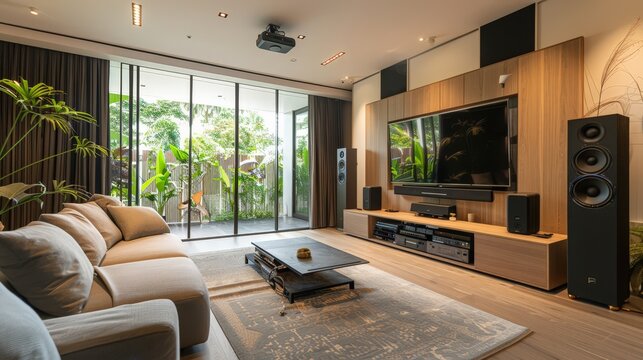When setting up a high-quality audio system, the speakers are often considered the most crucial element. They are responsible for translating the electrical signals from the stereo receiver into sound waves, delivering the music, movie soundtracks, or podcast dialogues that fill a room. With a wide variety of home audio systems available on the market, understanding their components, types, and features can help you choose the best ones for your needs.
What Are Stereo System Speakers?
Stereo system speakers are transducers that convert electrical signals from an audio source into audible sound. They consist of different parts, including the woofer (for low-frequency sounds), tweeter (for high-frequency sounds), and sometimes a midrange driver (for the middle frequencies). These components work together to produce a full spectrum of sound, providing a richer and more immersive audio experience.
Types of Stereo System Speakers
- Bookshelf Speakers
Bookshelf speakers are compact and designed to be placed on a shelf, table, or stand. Despite their smaller size, they can produce high-quality sound and are ideal for smaller rooms or spaces where floor-standing speakers might be too bulky. Bookshelf speakers typically excel in producing clear midrange and treble frequencies. - Floor-standing Speakers
Also known as tower speakers, floor-standing speakers are large and typically feature multiple drivers (woofers, midrange, and tweeters) for superior sound reproduction. They are ideal for larger rooms and can deliver powerful bass, detailed midrange, and clear treble. Their larger size allows them to handle a broader frequency range and provide more dynamic sound. - Satellite Speakers
Satellite speakers are smaller and are often part of a surround sound system. These are used to deliver high frequencies and work in combination with a subwoofer to handle the low-frequency sounds. They are typically mounted on the walls or placed on stands around the room for an immersive surround sound experience. - Subwoofers
Subwoofers are specialized speakers designed to handle the lowest frequencies, usually from around 20 Hz to 200 Hz. They provide deep bass and are essential for music genres like electronic, hip-hop, and movies that require strong, rumbling sound effects. Many stereo systems pair subwoofers with other speakers for a fuller, more balanced sound. - In-wall and In-ceiling Speakers
For a minimalist, space-saving approach, in-wall and in-ceiling speakers are built into the architecture of a room. These speakers are often used for home theater systems and can provide a clean, unobtrusive aesthetic while still offering great sound quality. - Smart Speakers
The rise of smart speakers like Amazon Echo, Google Nest Audio, and Apple HomePod has introduced wireless, voice-activated audio systems. These speakers combine Bluetooth or Wi-Fi capabilities with smart assistants, enabling hands-free control of music, news, and other services while providing decent sound quality for casual listening.
Key Features to Consider When Choosing Stereo System Speakers
- Sound Quality
The primary factor to consider is sound quality, which depends on several elements, such as frequency response, sensitivity, and impedance. A wider frequency response ensures that the speaker can reproduce a broader range of sound, from deep bass to sharp treble. Sensitivity measures how loud the speaker can get with a given amount of power. Ideally, you want speakers that offer clear, balanced sound with minimal distortion. - Power Handling
Power handling refers to the amount of power a speaker can safely handle without damaging its components. A higher power rating means the speaker can produce louder volumes. However, it’s important to match the speaker’s power rating with your stereo amplifier or receiver to avoid overloading the system. - Impedance
Impedance is the measure of electrical resistance in a speaker. Most home stereo systems feature speakers with an impedance of 4, 6, or 8 ohms. Make sure your receiver or amplifier matches the impedance of your speakers to ensure efficient operation and prevent damage. - Placement
Where you place your speakers can have a significant impact on sound quality. Bookshelf speakers should be placed on stable surfaces, while floor-standing speakers are best positioned away from walls to allow for optimal bass response. Subwoofers should be placed in corners or along walls to enhance low-frequency output.
